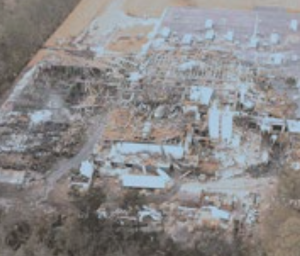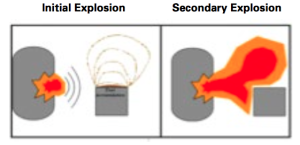
Pharmaceutical Plant After Dust Explosion (OSHA)
The Occupational Safety and Health Administration (OSHA) highlights the explosive dangers of combustible dust, the industries most at risk, and what employers and employees can do to prevent and mitigate these risks.
OSHA Hazard Alert: Combustible Dust Explosions:
Combustible dusts are fine particles that present an explosion hazard when suspended in air in certain conditions. A dust explosion can be catastrophic and cause employee deaths, injuries, and destruction of entire buildings. In many combustible dust incidents, employers and employees were unaware that a hazard even existed. It is important to determine if your company has this hazard, and if you do, you must take action now to prevent tragic consequences.
How Dust Explosions Occur
In addition to the familiar fire triangle of oxygen, heat, and fuel (the dust), dispersion of dust particles in sufficient quantity and concentration can cause rapid combustion known as a deflagration. If the event is confined by an enclosure such as a building, room, vessel, or process equipment, the resulting pressure rise may cause an explosion. These five factors (oxygen, heat, fuel, dispersion, and confinement) are known as the “Dust Explosion Pentagon”. If one element of the pentagon is missing, an explosion cannot occur.
(OSHA)
Catastrophic Secondary Explosions
An initial (primary) explosion in processing equipment or in an area where fugitive dust has accumulated may dislodge more accumulated dust into the air, or damage a containment system (such as a duct, vessel, or collector). As a result, if ignited, the additional dust dispersed into the air may cause one or more secondary explosions. These can be far more destructive than a primary explosion due to the increased quantity and concentration of dispersed combustible dust. Many deaths in past incidents, as well as other damage, have been caused by secondary explosions.
Industries at Risk
Combustible dust explosion hazards exist in a variety of industries, including: agriculture, chemicals, food (e.g., candy, sugar, spice, starch, flour, feed), grain, fertilizer, tobacco, plastics, wood, forest, paper, pulp, rubber, furniture, textiles, pesticides, pharmaceuticals, tire and rubber manufacturing, dyes, coal, metal processing (e.g., aluminum, chromium, iron, magnesium, and zinc), recycling operations, fossil fuel power generation (coal), and 3D welding (a form of 3D printing).
Prevention of Dust Explosions
- Identify factors that may contribute to a explosion, OSHA recommends a thorough hazard assessment of:
- All materials handled;
- All operations conducted, including by-products;
- All spaces (including hidden ones); and
- All potential ignition sources.
Dust Control Recommendations
- Implement a hazardous dust inspection, testing, housekeeping, and control program;
- Use proper dust collection systems and filters;
- Minimize the escape of dust from process equipment or ventilation systems;
- Use surfaces that minimize dust accumulation and facilitate cleaning;
- Provide access to all hidden areas to permit inspection;
- Inspect for dust residues in open and hidden areas at regular intervals;
- If ignition sources are present, use cleaning methods that do not generate dust clouds;
- Use only vacuum cleaners approved for dust collection; and
- Locate relief valves away from dust deposits.
- Ignition Control Recommendations
- Use appropriate electrical equipment and wiring methods;
- Control static electricity, including bonding of equipment to ground;
- Control smoking, open flames, and sparks;
- Control mechanical sparks and friction;
- Use separator devices to remove foreign materials capable of igniting combustibles from process materials;
- Separate heated surfaces from dusts;
- Separate heating systems from dusts;
- Select and use industrial trucks properly;
- Use cartridge-activated tools properly; and
- Use an equipment preventive maintenance program.
Injury and Damage Control Methods
- Separation of the hazard (isolate with distance);
- Segregation of the hazard (isolate with a barrier); • Deflagration isolation/venting;
- Pressure relief venting for equipment;
- Direct vents away from work areas;
- Specialized fire suppression systems;
- Explosion protection systems;
- Spark/ember detection for suppression activation;
- Develop an emergency action plan; and
- Maintain emergency exit routes.
We Fight for Victims of Catastrophic Workplace Accidents in Georgia …Contact us Now for a Free Consultation.
The Murray Law Firm has recovered millions of dollars for victims of catastrophic workplace accidents in Georgia, and we offer our legal assistance if desired. We represent our Clients on a contingency agreement, which generally means that no fees or payments are owed until and unless we recover. Anyone seeking further information or legal representation is encouraged to contact us via e-mail (click here) or by telephone at 888.842.1616. Consultations are free and confidential.
Choosing the Right Attorney
Selecting the right attorney for you or your family is highly important. You must feel confident that the attorney you hire has a complete understanding of the law applicable to your particular case, and has successful experience in handling such cases.
Important: Do not hire a lawyer who has violated the Rules of Professional Conduct!!!
You should not hire an attorney who calls you or visits you unsolicited, or anyone that contacts you directly to offer legal services. This activity is strictly prohibited by Rule 7.3 of the American Bar Association (ABA) Model Rules of Professional Conduct, which states as follows:
 A LAWYER “SHALL NOT” CONTACT A PROSPECTIVE CLIENT THROUGH A “LIVE TELEPHONE” OR AN “IN-PERSON” VISIT.
A LAWYER “SHALL NOT” CONTACT A PROSPECTIVE CLIENT THROUGH A “LIVE TELEPHONE” OR AN “IN-PERSON” VISIT.
– RULE 7.3, ABA MODEL RULES OF PROFESSIONAL CONDUCT.
If an attorney, or someone acting on behalf of an attorney, contacts you in this manner, that attorney is in violation of this Rule. This unethical and unprofessional activity on the part of the lawyer is good sign that you should stay away. It is imperative that you are represented by an attorney who is capable of advocating for you within the confines of the law, and an attorney who fails to abide by the Rules of Professional Conduct is probably not the best fit. In fact, any such attorney should be immediately reported to the local State Bar Association. If you have been contacted in such an unsolicited manner, contact us and we’ll assist you in filing a report.

Contingency Fees Disclaimer: “Contingent attorneys’ fees refers only to those fees charged by attorneys for their legal services. Such fees are not permitted in all types of cases. Court costs and other additional expenses of legal action usually must be paid by the client.”
 Georgia Legal Report
Georgia Legal Report



